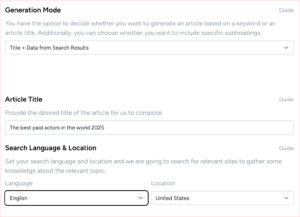A/B testing is a powerhouse tool in the arsenal of any digital marketer aiming to optimize their website. By comparing two versions of a web page to see which performs better, you’re not just guessing what works—you’re relying on concrete data.
However, to really harness the full potential of A/B testing, it’s crucial to follow best practices that ensure reliable, actionable results. In this article, we’ll dive into these best practices, covering everything from setting clear objectives and choosing the right variables to test, to analyzing your results with precision.
Whether you’re just starting out or looking to refine your approach, these tips will help you make data-driven decisions that can significantly enhance your website’s performance.
Importance of AB Testing
AB testing significantly enhances your decision-making by directly comparing two variables to determine which performs better. You’ll see real-time feedback on user behavior, enabling you to make data-driven decisions rather than relying on guesswork. This method cuts through subjective opinions, providing clear evidence about what works best on your website.
By implementing AB tests, you’re not just guessing what might appeal to your audience; you’re actively learning from actual user interactions. This approach ensures that every change you make is justified with solid data, maximizing your chances of success.
Instead of implementing broad, untested modifications, AB testing allows you to refine and optimize your site’s elements based on proven user preferences, significantly boosting your site’s effectiveness and user engagement.
Setting Clear Goals
Before you launch an AB test, it’s crucial to set clear, measurable goals to guide your experiment and evaluate its success. You’ll want to define what success looks like for your website optimization. Is it increasing the conversion rate, boosting the average order value, or reducing the bounce rate? By pinpointing exactly what you’re aiming to improve, you can tailor your AB test to directly address those aspects.
Don’t just think in broad terms; specify how much improvement you’re aiming for. For instance, you might target a 20% increase in sign-ups or a 15% decrease in cart abandonment rates. This precision not only focuses your efforts but also provides a concrete benchmark against which you can measure the outcome of your test.
Choosing Test Variables
Selecting the right variables for your AB test is crucial to its success. You’ll want to focus on elements that directly impact your key performance indicators. It’s about figuring out what changes will influence user behavior significantly. Don’t just guess; use data from your analytics to identify potential variables.
Consider testing different versions of high-traffic pages, call-to-action buttons, or even headline variations. The variables should be relevant and have the potential to impact conversion rates or other desired outcomes.
Remember, the goal isn’t just to see a change, but to understand how specific changes can lead to improvements. Keep your test variables manageable and focused to ensure clear, actionable results from your tests.
Implementing Proper Tracking
Once you’ve chosen your test variables, it’s crucial to set up accurate tracking to measure their impact effectively. You’ll need to ensure that each visitor’s interaction with the variables is recorded meticulously. Start by integrating analytics tools like Google Analytics or Adobe Analytics into your site. You’ll want to create distinct tracking codes for each version of your test to see which performs better.
Remember to test your tracking setup before launching the AB test to ensure data accuracy. This involves checking if the tracking codes are firing correctly on all test elements.
Don’t overlook the importance of monitoring these results in real-time. This allows you to make adjustments quickly if something isn’t working as expected.
Proper tracking is the backbone of any successful AB test.
Understanding Statistical Significance
Understanding statistical significance is crucial to interpreting the results of your AB test accurately. This concept helps you determine whether the difference in performance between your A and B variations is due to your changes or just random chance. Basically, it’s about being confident that what you’re seeing isn’t a fluke.
To grasp this, you’ll need to look at the p-value of your test results. A p-value less than 0.05 typically means there’s less than a 5% probability that the observed differences occurred by chance, suggesting your experimental change likely caused the improvement.
However, don’t just rely on p-values alone. It’s also essential to consider the effect size, which tells you the magnitude of the change, ensuring it’s not only statistically significant but also practically meaningful.
Test Duration Considerations
Deciding how long to run your AB test is crucial for gathering reliable data. You’ll want to ensure the test lasts long enough to capture meaningful user behavior but isn’t so long that it delays decision-making. Typically, you should aim for at least one full business cycle, which could range from a week to a month, depending on your industry.
Consider your website’s traffic volume too. High-traffic sites may reach statistical significance quicker than those with fewer visitors.
It’s vital not to cut the test short just because you’re eager for results. Running it for a predetermined period allows you to avoid biases introduced by external factors like holidays or special promotions that could skew your data.
Analyzing Test Results
Once your AB test concludes, you’ll need to analyze the results carefully to understand the impact of the variations. Start by comparing key performance indicators (KPIs) between your control group and the variation. Look for statistically significant differences in metrics like conversion rates, bounce rates, or average time on page.
You’ll also want to dive into the details. Use visualization tools to spot trends and outliers in the data. Consider segmenting your results by different demographics or user behaviors to uncover deeper insights.
Don’t just focus on the “winning” variation; understanding why certain changes did not work can be just as valuable. Ensure your statistical methods are robust to avoid drawing incorrect conclusions from your data.
Iterating for Continuous Improvement
Once you’ve analyzed your AB test results, it’s crucial to use those insights to refine your strategies and test again for continuous improvement. This iterative process helps you consistently enhance your website’s performance. Don’t just make changes; ensure each iteration builds on the last. You’re not starting from scratch but rather fine-tuning elements that didn’t perform as well as expected.
Consider tweaking one variable at a time to pinpoint what exactly impacts user behavior. This way, you can be more confident that your changes are effective.
Remember, AB testing is not a one-off but a continuous cycle of testing, learning, and improving. Keep challenging your assumptions, and always look for new opportunities to optimize further.
Segmentation Strategy
Segmentation strategy enables you to tailor your AB tests to different user groups, enhancing the relevance and effectiveness of your results. By identifying key characteristics like age, location, or behavior, you can create distinct segments. This approach ensures you’re not treating all users as a homogeneous group, which often leads to misleading data.
When you segment your audience, you’ll understand which changes positively affect different groups. For instance, younger users might respond better to one type of call-to-action compared to older users.
This knowledge helps you optimize your website more effectively, boosting conversion rates and overall satisfaction. Remember, what works for one segment may not work for another, making segmentation crucial for targeted testing and optimization.
Mobile-Friendly Testing
You’ll need to ensure your AB tests are mobile-friendly, as an increasing number of users access websites via mobile devices. This means designing your tests to adapt seamlessly to smaller screens and touch-based interfaces. Focus on simplifying elements and reducing load times to improve the user experience on mobile.
You should also consider the different browsing behaviors on mobile, such as increased scrolling and varied interaction patterns compared to desktop users.
It’s crucial to validate that your variations perform well and maintain functionality across all mobile browsers. Remember, a test that looks great on a desktop might not translate well to a mobile environment, so always prioritize mobile optimization from the start of your AB testing process.
Testing Different Devices
You must also test your AB variations across different devices to ensure consistency in user experience and functionality. This means evaluating how your website performs on smartphones, tablets, and desktops. Each device has its own screen size, resolution, and processing power, which can affect how content is displayed and interacted with.
Don’t assume what works on a desktop will work on a mobile device. Users often have different expectations and behaviors depending on the device they’re using. It’s crucial you’re aware of these nuances.
For instance, touch interfaces on smartphones and tablets require different design considerations compared to mouse-driven interfaces on desktops. By testing across these platforms, you’ll ensure your site is optimized for all users, regardless of how they access it.
Testing Across Browsers
You should also verify that your AB tests perform consistently across various web browsers. Differences in rendering, JavaScript performance, and CSS support can skew your data, leading to inaccurate conclusions. It’s crucial to check your website’s functionality on major browsers like Chrome, Firefox, Safari, and Edge. This ensures that all segments of your audience have a seamless experience, regardless of their browser choice.
Don’t just settle for desktop browser testing; consider mobile browsers as well, which often display content differently. Use browser emulation tools to simulate different environments and catch issues that could affect your test outcomes.
Remember, a browser’s quirks can significantly influence user behavior, and ultimately, your test results. Keep your testing thorough and your data interpretation accurate.
User Experience Testing
User experience testing ensures your AB tests resonate effectively with your audience, providing actionable insights into user satisfaction and behavior. You’ll want to focus on how real users interact with your variations, not just which version performs better statistically. It’s about understanding the why behind user actions. Are they finding what they need easily? Is something in your design making them hesitate?
To get started, gather qualitative feedback through user interviews, surveys, and usability tests. Watch for patterns in how different segments react. This direct feedback helps you optimize not only for conversions but also for a better overall user experience.
Remember, a positive user experience often translates into higher engagement and loyalty, which are just as valuable as any conversion metric.
Multivariate Testing Techniques
Multivariate testing lets you explore how multiple variables interact to affect your site’s user experience and conversion rates. Unlike A/B testing, which compares two versions of a single element, multivariate testing allows you to mix and match multiple elements simultaneously to see which combination performs best.
You’ll start by identifying key elements—like headlines, images, and call-to-action buttons—that you suspect impact user behavior. Next, you’ll create variations of these elements. The testing software then combines these elements in various ways across your site, tracking which combinations drive the most conversions.
It’s crucial you’ve got enough traffic to achieve statistical significance, or you won’t know if the results are reliable. So, make sure you’re prepared for a bit of number crunching!
How can small businesses implement A/B testing with limited resources and budget?
When resources and budget are limited, start by focusing on key website elements like headlines and call-to-action buttons.
Use free or low-cost tools for A/B testing and analyze results to make informed decisions.
What are the potential ethical concerns associated with A/B testing on websites?
When A/B testing on websites, be mindful of potential ethical concerns. Ensure transparency, respect user privacy, and avoid manipulating or misleading visitors.
Strive for honest experimentation that benefits both your business and your audience.
Can A/B testing be effectively used for non-ecommerce websites, such as informational or non-profit sites?
Yes, A/B testing can be beneficial for non-ecommerce websites like informational or non-profit sites.
By testing different elements, you can optimize user experience, increase engagement, and achieve your website goals more effectively.
Conclusion
In conclusion, when optimizing your website through AB testing, remember to set clear goals, test one element at a time, analyze data accurately, and iterate based on results.
By following these best practices, you can make informed decisions that improve user experience and drive conversions.
Stay focused on continuous testing and refinement to ensure your website remains effective and competitive in the ever-evolving digital landscape.





